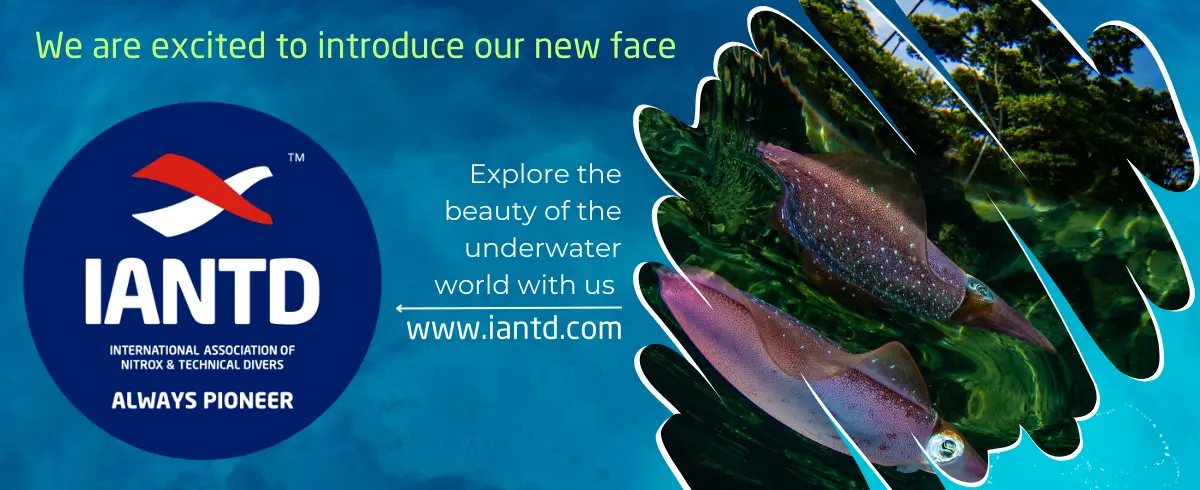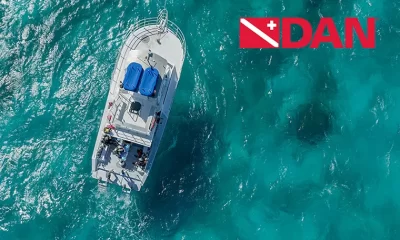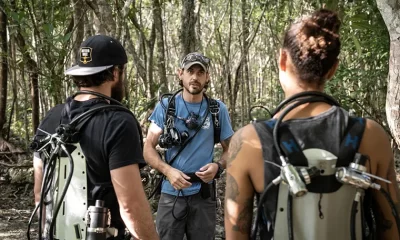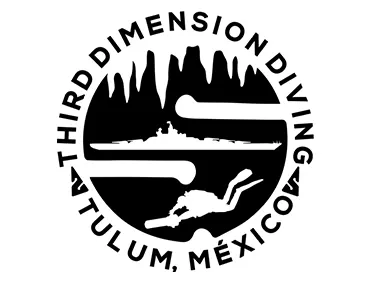Community
Introducing World Underwater Discovery – China’s Homegrown Tech Agency
Interview with WUD cofounder and president Yuan Wang by Michael Menduno.
Interview with WUD cofounder and president Yuan Wang by Michael Menduno. Images courtesy of WUD unless noted. Lead image collage created by Rico Besserdich.
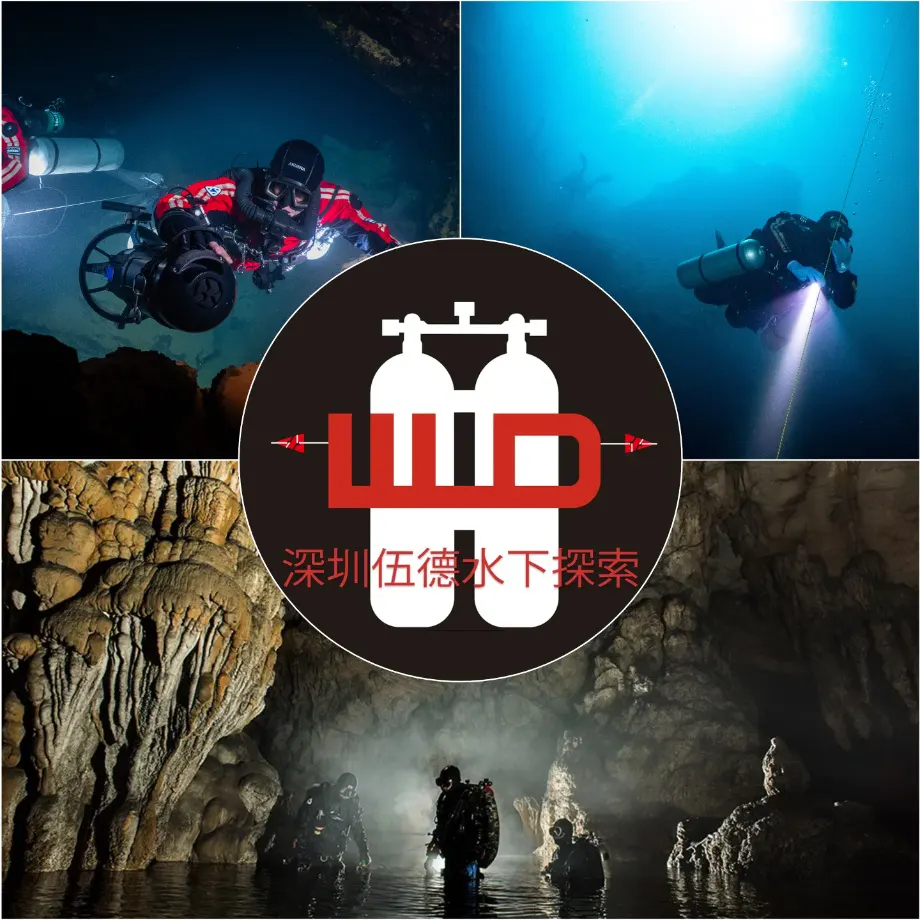
Forty-one year old co-founder and president of World Underwater Discovery (WUD) and Akuana, Yuan Wang studied law at the University and served in law enforcement for more than a decade before quitting his job to follow his predilection and become a diving professional. He and his colleagues founded WUD in 2013, and later started equipment manufacturer Akuana, to supply divers and instructors with gear. Both companies are based in Shenzhen, China,
InDEPTH met up with Wang in Palm Springs, California as he traveled home from his annual cave diving trip to Florida. There I asked him about tech diving in China, the establishment and doings of WUD and Akuana, and his goals and plans for the future. Here is what the man had to say.
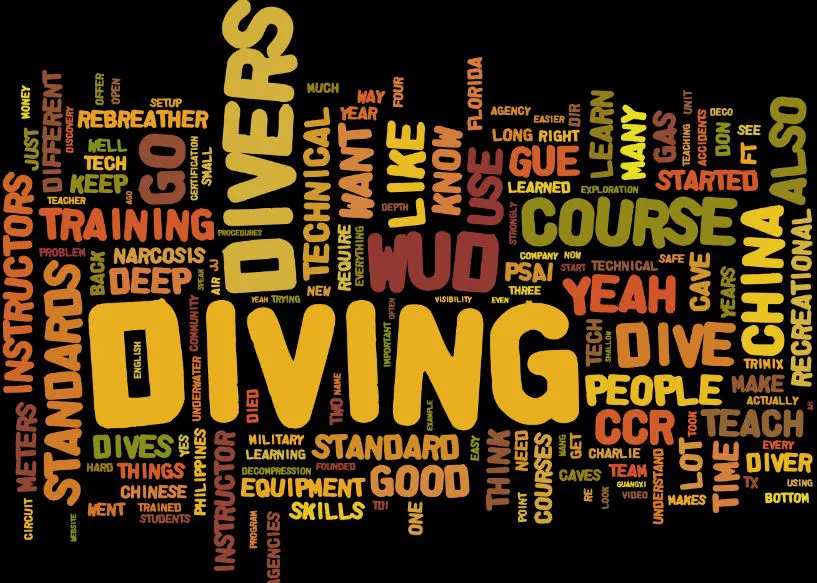
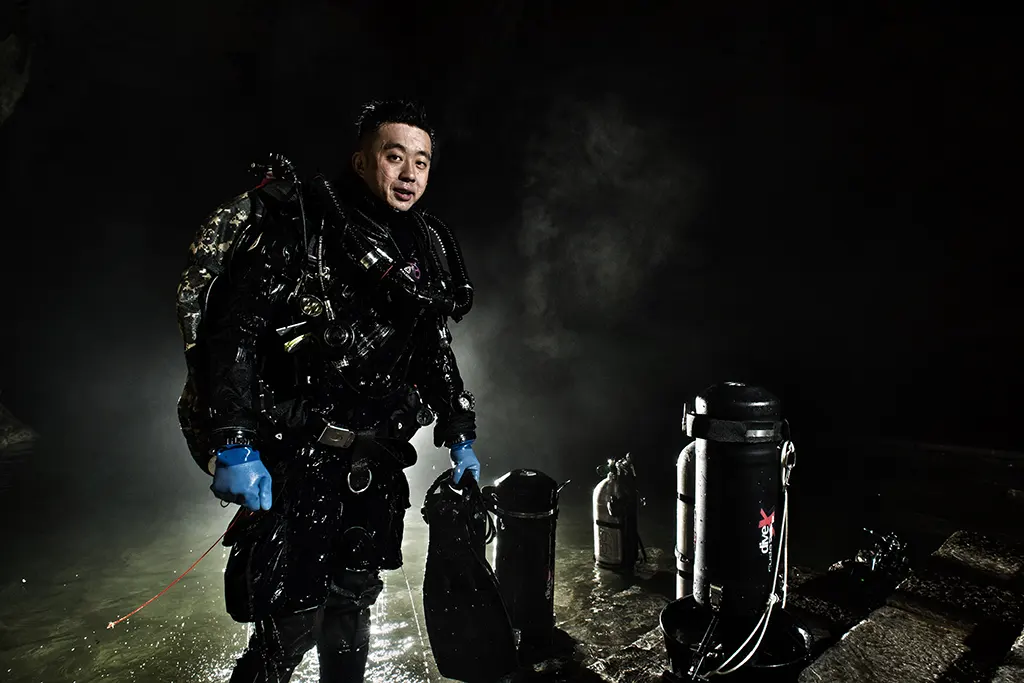
InDEPTH: In the West, we have very little visibility into the diving scene in China. How many tech divers are there in China?
Yuan Wang: In China, I think one in a hundred divers is a technical diver; there are very few. Most divers here do recreational diving or just learn the basics of technical diving. They travel a lot in Southeast Asia. But as far as technical diving, it’s always been a very, very small community, and so is rebreather (CCR) diving. There are more now than there were 10 years ago, but it’s not a big group. I personally know most of the people who are using CCR. Yeah, so that’s why I call it a small community.
And how about from your side Wang? Are most Chinese tech divers aware of what’s going on in other tech communities outside China?
I think so. Yeah. Most tech divers here got trained outside of China from the States, Europe, SE Asia, Philippines and Malaysia. So, they know what’s happening outside China.
I understand that there are also few beginner i.e., shallow caves in China, and so people go elsewhere to learn.
That’s right. The caves are deep, they’re not for beginners. We have been searching for caves here for more than 10 years, but we cannot find caves like in Florida for training divers. So that’s why the community is small, because people have to go at least to the Philippines or Indonesia to learn long penetration cave diving.
And do most Chinese divers speak English?
No, that’s also a problem. Since most of them don’t speak English,they must go to a dive shop with a Chinese speaking instructor, of which there are very few. Most of the good instructors don’t speak Chinese, so that limits the market here. We need instructors who speak English, who can learn abroad, and then come back to China to teach.
I’m in contact with one of your WUD instructors, Chen Qian aka “Charlie.” He reached out to us at InDEPTH with an article on his experiences with High Pressure Nervous Syndrome (HPNS), which we have included in this issue.
Very good. Charlie is one of our tech instructors and instructor trainers. He’s a person who likes reading many magazines, the English versions, and is also always researching diving and decompression theories over the internet. He’s that kind of person. I’m often too busy with my companies, so I don’t have much time to read everything. But when Charlie finds something interesting, he talks to me about it, “Ah, this theory is changing, or someone has a new theory about this. He’s always talking to me. He’s a young man, but he has a good philosophy. He’s not rushed. He takes his time learning and practices a lot. He knows everything has to go slow.
Sounds like a great person to have your team. You told me that you learned to dive in 2004, and started WUD in 2013. Ιn the process, you trained with a number of different agencies, and became an instructor for some of them. I understand you also took GUE classes with now instructor evaluator, Graham Blackmore.
Yes, Fundamentals and Tech 1.
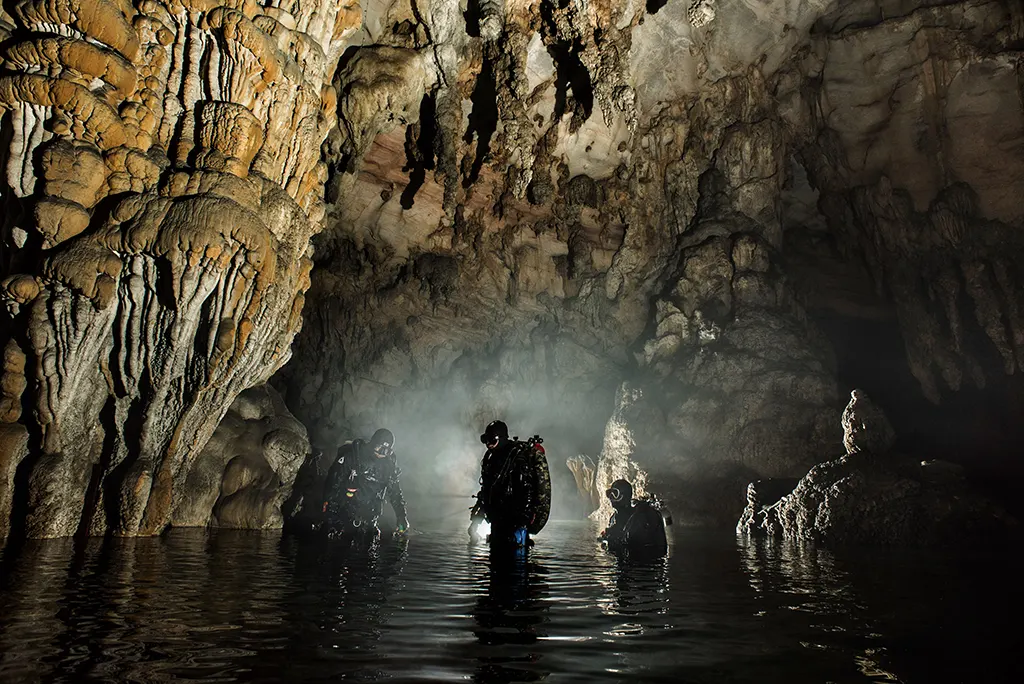
You also trained with Professional Scuba Association International (PSAI)?
Yes. I started with PSAI. There is a guy called Stephen Chan, who was an early member of PSAI. He started learning a very long time ago in Florida and Mexico, I think in the 1980s, like that. So, he’s a pioneer in China for cave diving. But he’s from Hong Kong. It’s not the mainland, and he spent maybe five years in the States and Mexico. There were very few people cave diving then, so then he became a member of PSAI, I think, maybe a director.
He then went back to China and he started training PSAI in China. I took my first technical diving course from him. He taught me cave diving, wreck diving, and deep diving. Then he introduced me to Florida. He said, “You are a cave diver, you must go to Florida.” So, he introduced me to PSAI founders Gary Taylor and Hal Watts. So, I came to Florida, 2009, and we spent some time diving, and I took further courses in Florida. Since then, I have returned every year. Sometimes we go diving, and sometimes we teach there.
So your first cave dive was in Florida?
Yeah, Peacock Springs in 2009!
Cave country! And then you returned and started cave diving in China.
That’s right. In Guangxi. It’s a mine from the Ming Dynasty, which was from 1364 to 1644—a long time ago. We dived some other caves in Guangxi province after that. But, you know, in China, the caves are not like Florida and Mexico. The visibility is poor, and instead of distance, they have depth. In Guangxi, there are many deep sinkholes but very few not shallow ones, and you can’t travel a great distance. I still go to Florida for long distance dives.
You became an instructor with several agencies.
Yeah. I was an instructor with PSAI, Technical Diving International (TDI), PADI, and Unified Team Diving (UTD) but I have not renewed any of them.
Let’s talk about your training agency. What motivated you to form World Underwater Discovery (WUD)?
My original partner was Tao Wang. We founded the Whitetip Shark Underwater Discovery in 2010 as a dive club, not an agency, which issues standards. We were just a group of technical divers. At that time, of course, there were very few technical divers in China. So, we decided to form a club. We traveled to Guangxi and other parts of China for some exploration diving. In China it’s easy to find a cave that no one has dived before. Next, since everyone’s backgrounds, training, and procedures were different, we agreed to have uniform standards.
Having operational standards makes a lot of sense. Most professional diving communities have them.
We agreed that we needed to create some agreed-upon standards and emergency procedures, so that we all planned and executed our dives in the same way. We spent about four years sorting out every standard, and started issuing certifications in about 2013.
Standard configurations, gases, deco, procedures, all of that?
Yeah. It took a while because, you know, people from different agencies, had very different philosophies. Like PSAI, they told me you can do what you want, for example, you can put your long hose in a bungee. Some divers like that. Conversely, GUE and many other agencies treat their long hose as the primary. All of the agencies are different.
So, we had to agree on what setup was good, what setup was not acceptable because of some potential danger. So, we spent four years sorting it out. At that point, we decided we could promote the standards to the new divers. We began offering certifications to divers taking our classes in 2013.
Unfortunately, Tao Wang died in a deep diving accident in 2014. We have three partners now. Myself, Ming Chen who helped write the manuals, and Bai Wei, who is in charge of diving the programs. We have an office in Shenzhen. Our company registration name is: 深圳伍德水下探索. We also have two full time staff for our video examination and certification, and some part time staff as well.
Some people are going to say, “World Underwater Discovery” (WUD),” that sounds an awful lot like “Global Underwater Explorers” (GUE).” What’s with that? Did you mean to copy GUE?
No. We started using the name in 2010. At that time, I had not learned of GUE yet. We founded the club as Whitetip Shark Underwater Discovery. Whitetip Shark was the name of our dive center. So, we called it WUD. But when we started to certify divers in 2013/14, we wanted to keep the name as WUD, but we changed it slightly to “World Underwater Discovery.”
GUE is a very good agency. We learned a lot from them. They have good ways of teaching and a good system. But we would never simply copy their name. You can explain that in your article. It’s like PSAI and PADI. They look similar but they are actually different.

I went to your website but it’s in Chinese.
It is. We have the manuals too, but they’re all in Chinese. This is a problem. You know what? We go to Ginnie Springs every year. This year we went to teach, but the Ginnie staff went to our website and couldn’t read anything. So, they said, “We don’t know your status. We cannot let you teach. You can go diving, but not teaching.”
Because they couldn’t verify anything from your website. They couldn’t read it.
It reminded me that we need to translate our standards into English. We have standards, general standards that specify what equipment, minimal equipment requirements etc. We strongly support the “Doing It Right” (DIR) concept. For our technical diving, we use the same DIR configurations. For gas, we borrow both from GUE and PSAI philosophies. GUE, of course, uses trimix (helium) below 30 meters, right? But the PSAI, has their narcosis management course.
I am aware of it. I’ve even written about it in a piece called “Rapture of the Tech: Depth, Narcosis and Training Agencies”
Yeah, yeah, it’s interesting, I learned both courses. In our standards we combine the two because I think the right approach depends on the conditions. If you are diving in warm crystal clear water in the Philippines or Caribbean you don’t have narcosis at 30 meters. You can go 40, 50, no problem, especially for short dives, it’s an easy environment. But in some cold water lakes—we dived in some high altitude lake in China with low visibility, and if you go to 50 m/164 ft, you get a lot of narcosis. It’s different.
For our standards, we train both. You should know your limit. If you go down to 40 m/131 ft, and you feel narcosis, then you should use a trimix. If you use trimix, we support the standard gases, because it’s easier to blend. It’s easier to remember. It’s safe. We don’t do customized mixes. We just do the standard gas, like GUE or UTD. But for some environments, we train our students to do the narcosis management. So, it depends.
Depends on the divers and the environment?
Yeah, I found it a very interesting thing. All GUE divers learn their courses with 30 m/100 ft maximum narcosis. But then they go diving in the Philippines, and they don’t use helium because it’s expensive and hard to get in the Philippines. And they dive to 40, 50 meters. But actually, they weren’t trained to manage the narcosis. So maybe they will make some mistakes and or have an accident.
However, if you learned trimix and narcosis management in the course, then you can judge which environment you can use trimix, and which environment you use air. But, if you know you have narcosis below 30-40 m, you should use a standard gas like trimix 21/35 (21% O2, 35% He).
I understand PSAI has a narcosis management course, but it’s not clear to me to what extent that narcosis can actually be managed. What’s the deepest you allow air diving?
Under the right conditions and right diver, we allow air dives to a max 63 m/206 ft. But you need to control your PO2. It’s only for a touch-down dive. This would only be taught in Tech 2; it’s the only time we dive to a PO2 of 1.5 atm. On other courses and dives we keep the PO2 at or below 1.4
For your bottom gas?
Yeah, we keep our PO2 for bottom gas 1.2 to 1.4. And for deco gas 1.6. Yeah, and for recreational divers, we also teach recreational diving. It’s 1.4 for recreational divers.
And you mentioned you teach standard gases for bottom mix and deco. These are, for the most part, the same as GUE’s standard gases. I assume that was intentional.
Yes. It is a well recognized blend of gas with great advantages. The standard gases are easy to blend, and easy to remember. We decided to adopt them as soon as we learned about this. It just makes good sense, though most agencies don’t use them.
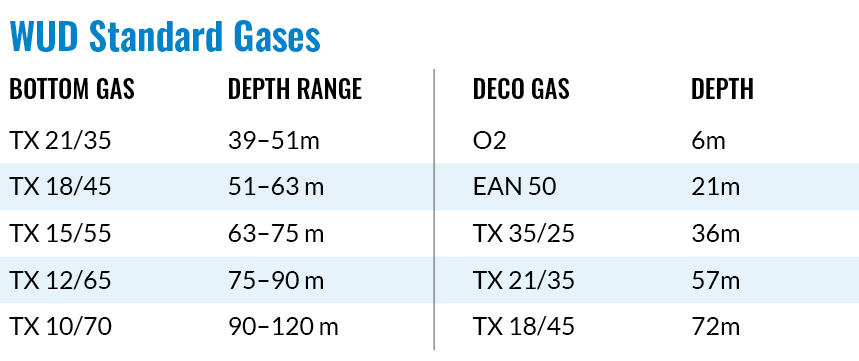
I can’t argue with that. Is EAN 32 (nitrox 32) also a standard WUD gas for shallow diving or do you use air to 30m?
EAN 32 is not a standard gas. It is standard for a nitrox course, of course. We use air a lot. Most dive shops don’t offer nitrox, and it’s very hard to store oxygen in your house or a dive shop in China—you cannot pass fire inspection with the government. Compressed gas and other things are all heavily regulated. So for normal dives, we don’t usually risk blending nitrox 32. But when we do technical diving in China, we blend the standard gas. It’s worth the trouble.
Interesting. As you know nitrox is fairly ubiquitous in the States—thank you Dick Rutkowski—and in most of Europe. So what is WUD’s mission? What are its aspirations?
Our mission is to promote a safe way of diving based on standards and a standard way of training. Because in China, the standards are always a problem. Because people learn from PADI, but they don’t teach as PADI standard. People learn from TDI, but they don’t teach their standards. Instructors have too much freedom to decide how to teach. Of course, every agency has many responsible instructors who teach according to the standards.
So, we founded WUD because we want people to have the same idea about diving, the same configuration about diving, so they can dive safe. Before that, people came from different backgrounds and had different ways of diving. In fact, they often separate during the dive and are essentially solo diving. They don’t have enough awareness about their buddies, and their equipment. So, we think it’s important to have standards that divers adhere to.
So WUD promotes team diving?
Yes, but from 2020, we changed things slightly. Because some diving should be alone. Like Charlie’s (Chen Qian) dives.
You’re referring to uber-deep dives, record setting dives?
Yes, also for some very small cave diving.
Ah, Like the Brits—sump diving in the U.K.
That’s right so you cannot apply the standard there. Before Charlie started doing his deep dives, we didn’t allow solo diving—you have to dive with your buddy. That was our rule. But now it’s changed.
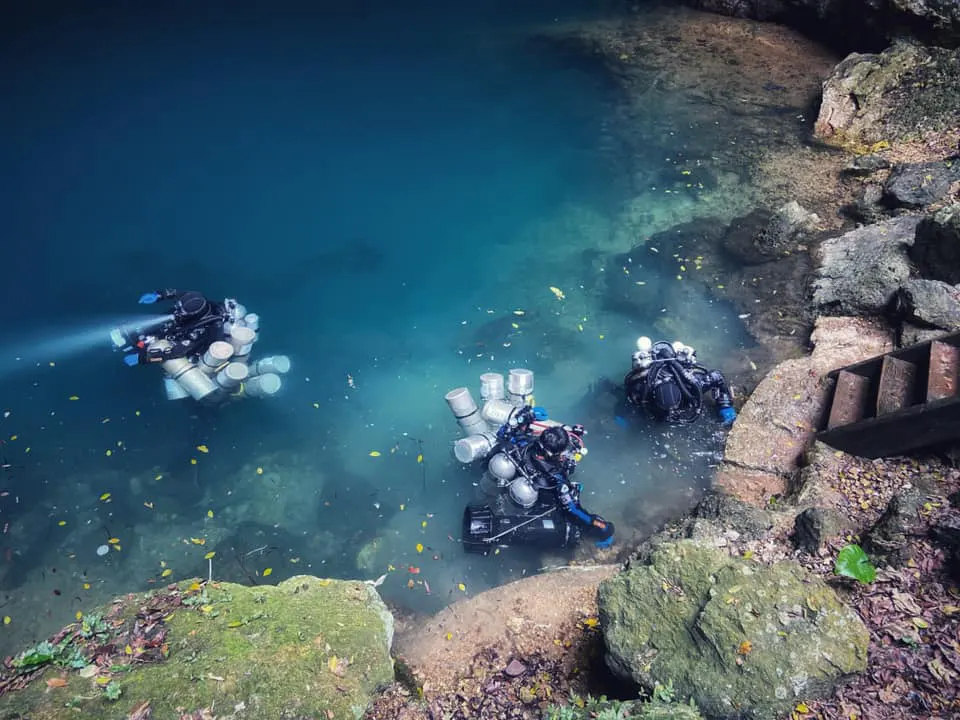
So you allow a single push diver by themselves with support divers above them?
We do, because if two people do extreme diving, it’s more dangerous. Two divers cannot watch after one another below 200 meters. It also depends on the size of the cave. If two divers go into a very small cave, it’s a nightmare. So, we changed our standards a little.
But in the beginning, we strongly mandated team diving. In most circumstances, team diving is safer, especially with rebreathers. I have seen many rebreather diving accidents in China, both with the army and with technical divers. For example, if you become hypoxic in shallow water, your buddy can save your life.
One of the consensus statements that came out of the Rebreather Forum—and there have been many solo CCR diving fatalities—is that the risk is higher when diving alone. Because if you have a problem and can’t self-rescue, then you’re going to die. There are many more insidious failure modes on a rebreather than open circuit diving, where you have a fixed gas mix(s) and things are not as dynamic as a rebreather.
For rebreathers, I think you need team diving except when you want to do some very extreme diving where nobody can go with you. But for normal diving, we require our students to do team diving.
WUD has an open circuit and a closed circuit program as well?
We do. For technical diving we only teach the JJ-CCR, similar to GUE. But, one of my partners, Bai Wei, who is also an instructor is learning the Gemini right now.
The new-ish sidemount rebreather by Fathom Dive Systems. [See: InDEPTH’s Holiday rebreather Guide]
Yes, they want to introduce that unit to China and Southeast Asia. We plan to introduce it to WUD as a sidemount unit, as a complement to our backmount rebreather program. We currently have three levels for the JJ courses; CCR1, CCR 2 and CCR3. We require at least WUD Technical Diver 1 qualification before joining the CCR course.
So Tech 1 includes tech diving skills, decompression diving, mixed gas use? And that’s a requirement to enter your CCR program.
It is. However, not everyone agrees. When I took my JJ instructor course, they recommended encouraging recreational divers to learn the rebreather. They didn’t even require nitrox training.
Huh! A few agencies offer CCR courses for recreational divers.
Some think recreational divers could learn to dive on rebreathers. I disagree with that point. I have been diving CCR more than 10 years, and I have seen a lot of accidents. I think it’s critical to have basic skills, along with an understanding of the physiology, physics, and everything you have to know about that. You have to know everything about the unit. So that’s why we require students to have finished their technical diving training before they learn the CCR.
You also have to have experience with depth. For example, if you want to go to 60 meters (nearly 200 ft) with CCR, you have to be a good open circuit diver to 60 meters, then you can learn the CCR to go to that depth. Because if you bail out, you use open circuit, but if you have never dived to that depth with open circuit, it’s not safe.
So, for CCR Level 1, we don’t require students to use the DIR setup. They can use the original or stock setup. But for the CCR2, it’s a decompression CCR course, we strongly recommend and require them to use the DIR setup.
By DIR setup, you mean the GUE JJ-CCR configuration with dual manifolded diluent tanks.
This setup is very good for deep diving. It’s very small because it has diluent bottles manifolded like the doubles. And you have a lot of back gas there. It’s easier for deep diving. So, when we do deep diving with the JJ, or decompression diving with JJ, we require the DIR set-up.
But for the level one, the non-deco course, you can use the original. But the DIR setup has a problem if you use scooters. It’s much slower than the original set-up due to drag. That’s why we are learning the sidemount CCR, because it’s more streamlined when you use scooters in the big cave system.
Have you looked at other brands that offer the dual, DIR configuration, like DiveSoft?
I’ve seen the DiveSoft Liberty but I think it’s too complicated. I have used the JJ for a long time. It’s a very simple unit. For the CCR, I think simple is best. I also learned to dive the Poseidon CCR, but it has too many electronic parts and too many alarms. I actually think the manual (mechanical) CCR is safer than the electronic CCR.
Hence, you’re looking at Fathom.
That’s right. We made our own manual CCR as well.
WUD makes a rebreather?
No. Our equipment company, Akuana, makes the rebreather.
Ah, I see. You have a commercial equipment manufacturer as well. So is WUD also a commercial for-profit company as well?
No, no, no, no, no. WUD is just a club, an agency. We don’t make money from that.
So, it’s a non-profit or foundation like GUE or NAUI.
Yeah, it’s like that. We spend the money there because it’s not for profit. Because that’s our mission, we want the instructor and the diver to have the same standards. That’s why we cannot make money. If you want to make money, you have to attract different people that come and pay the annual fee, pay the certification fee, then you have to lower the standards. If someone wants to become a teacher, and they are maybe not a good teacher, a profit making organization may let them in, for the money. But then you lower the quality.
I understand the concern.
WUD actually has four parts. We start from technical diving with our technical diving standards. We also offer recreational training, and we have special courses for the military, because in China, the military is still using methods and equipment from the 1970s and 80s. So that’s why we are trying to make the equipment and the training methods for them. Because in China, they are very closed up.
Do you mean that they keep to themselves? They have restricted access to outside teaching?
Yes, they keep to themselves. They don’t learn from the States, they don’t learn from the UK. So, they don’t know the new methods, the new equipment. They learned a long time ago from Russia, and they haven’t advanced. So that’s why we are trying to help them.
By providing modern training?
Training, equipment, and standards, because their training is not standard. Their way of training is that I know how to dive, then I teach you and you teach him. It’s like that. It is easy to have an accident if you’re diving without proper training. We are trying to teach them the right way to dive. We’ve set up the standards for them, and also for the public safety divers.
Public safety diving is the fourth component?
We group military and public safety training together. The fourth part is helping environmental groups. There is some reef protection in China. We have joined their activities for protecting surveys of corals. Many divers step on the corals while doing research. So, we created a course for coral protection groups, so they don’t damage the corals they are researching. We add some technical diving basics and offer a two-to-three day course to improve their skills. Those are the four parts.
You mentioned that you also own an equipment company Akuana, which manufactures dive gear.
That’s right. Akuana makes diving equipment for recreational divers, technical divers, and military divers. We make a CCR for the military.
What kind of CCR?
It’s a mixed gas mechanical CCR. We do not want to push the military type unit to recreational or tech divers. The pricing is different. We may make another small unit for recreational divers. Let us see this or next year. We would use the same electronics.
You were at the BOOT show this year. Have you exhibited at the annual Diving Equipment and Marketing Association (DEMA) show as well?
Not yet. We checked it out in 2019, just before COVID but then had to stop. We will be there next year.
I see on the website that Akuana supplies a diverse set of equipment; diving suits, back plates, wings, BCDs, regulators, fins, masks—all of those items.
We started doing production in 2013. We started with drysuits. Originally, I used Diving Unlimited International (DUI) dry suits, but when I sent it in for repairs it took three months to get it back. So that’s why we did the dry suit first. We also do lights. When I started cave diving, I used the Halcyon backplate, Light Monkey lights and the DUI drysuit. But when something needs repairing, it takes a very long time to get it back, and it’s very expensive—both the shipping and the repair fees. We have an industry in China to make these things. They just needed help with the designs, because they are not divers. So, we helped them. That’s how we got started.
Let’s talk about training. Would a WUD course look familiar to me?
Yes, it probably would. We start with basic Recreational 1. It’s a technical foundation using a single tank, backplate and wings. That’s the starting point for recreational and technical. They learn the Basic Five skills, like GUE, and also the kicks—including backward and helicopter kicks. This course is not only for divers who want to dive with doubles, it’s also for the divers who don’t.
Divers then move on to Recreational 2 for training with doubles, where we teach them how to use the equipment and provide a technical foundation. After that, they can choose if they want to go deep diving, cave diving, or wreck diving.
And become a tech or cave diver. Great. So how long is a typical tech course?
Normally six days and at least 10 dives, so almost two dives a day.
This includes lectures, right? Do you have an e-learning system?
Not e-learning. We have powerpoint slides for lectures and a manual. Of course, currently they are in Chinese.
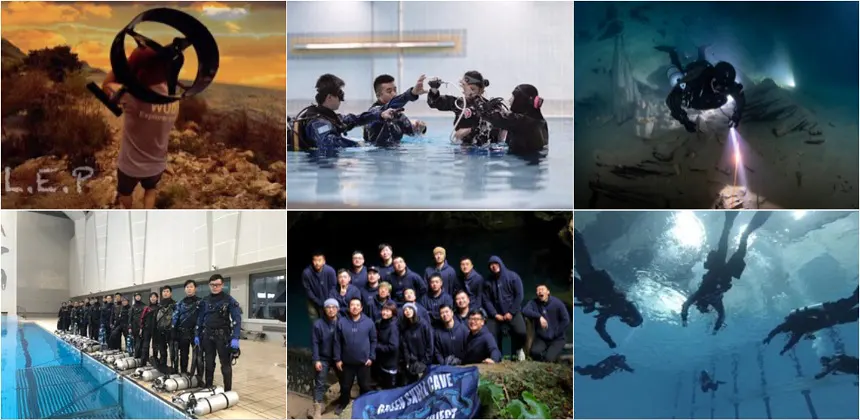
As you probably remember from your GUE classes, there is a big emphasis on problem solving—what to do when things break or go wrong— both as an individual and a team. Does WUD focus on problem-solving as well?
Of course. Problem-solving simulation is very important. In WUD courses, we have levels. In level one, the teacher demonstrates the skill and then the student demonstrates. In level two, the student demonstrates skills, while maintaining buoyancy and trim and while paying attention to the surroundings. In level three we simulate problems the student must address, and level four introduces multiple problems that must be solved by the team.
It sounds like something I would recognize as a GUE diver. What specific depth levels does WUD’s tech program include?
Technical 1 is 51 m/167 ft. Technical 2 is 63 m/207 ft, and Technical 3 is 75 m/246 ft. We also have another course for 100 meters/328 ft. We include diver propulsion vehicle (DPV) training beginning with Technical 2, because you have to use a DPV for deep diving, where you’re typically carrying lots of tanks. Like GUE, we require experience dives to progress through the Tech and CCR courses.
DPVs are obviously important to reduce the workload, particularly on deep dives. So then students progress through the series?
After Tech 1, divers can choose Tech 2, begin our JJ-CCR program, or they can take the 100 meters (328 ft) course. That course is actually much easier.
Easier? I don’t understand.
We created this course in 2020. It’s easier because divers just touch down at the bottom. The 100 meter dive is less than an hour in runtime, compared to Tech 2 and Tech 3, where students are doing 20-30 minutes of bottom time, followed by decompression resulting in much longer dives. The 100 m dive only requires three tanks, they leave their deco stage in the shallows and don’t use a DPV. Many people choose the 100-meter course because they like the depth.

Curious. So, the course is just about doing a short bounce dive to 100 meters? How did the course come about?
We taught a lot of Technical 1 divers who then went to the Philippines, and did a 100 meter dive course with TDI or other institutions, because they wanted to go deep. They have a good foundation, but they didn’t go on to take Tech 2. Instead, they go to the 100 meters with another agency for less money than our Tech 2 course. You know, it’s like a gift to the agencies because they have very good skills. It’s easy to teach them to do the 100 meters.
So, after a lot of students did this, we decided we should offer our own deep diving course. Long bottom time diving is much more complicated than a 100 m/328 ft dive. In contrast, a 100 m dive in the Philippines is relatively safe and easy. It doesn’t require as many skills. Many people just hold the descent line, and some even teach it that way. We use a trimix 12/65 as the standard gas [Ed note: PO2=1.3 atm, END=29 m/92 ft]. It’s a less expensive course than Tech 2.
100 meters! People want to do it for bragging rights, I guess. Any other important aspects to WUD courses?
The most interesting thing about our courses is that students have to provide a video of their skills and diving to our qualification committee, who review the video. We have a list of skills for each course. They don’t receive their certification until their video is approved.
GUE uses video as a teaching tool during its courses, but you use it for certification? Students have to arrange for themselves to be videoed on an actual dive and demonstrate their skills and then submit that in order to get certified?
Yes. That’s the way we control the quality and make sure the instructor does their job. We can see their skill level and how they look in the water. That’s the point. It also discourages people who don’t want to go to WUD because it’s too many procedures and work. The people who chose us, do so because they want to do the things that WUD divers are able to do. I imagine it’s like that with GUE as well.
Are your instructors insured like they are in the US and Europe?
Yes, we have been recognized as a training agency by an insurance company in China for the last two years. That was an important step for us as an agency.
After speaking with Charlie, I understand that many of your members are explorers or hoping to explore.
That’s it. We founded WUD to provide training. But what’s the training for? It’s for exploration, not just for fun dives. It makes the fun dive safer, but our goal is exploration. I’m proud that most of our divers like exploration and want to push their limits. We dive quite a lot in Chinese caves and lakes, and we have maintained a good safety record in our courses.

Have you had any incidents or fatalities during WUD training or on your projects?
We haven’t had any accidents in training since we began 10 years ago, and no accidents on any of our organized exploration projects. But we have had four WUD trained divers die.
One was my partner Tao Wang, who died in 2014 on a dive below 150 m/492 ft. He was also PSAI, TDI, and GUE trained. He died in Da Xing, where Han Ting died last year. I thought I fancied deep diving, but after that, I no longer do dives below 150 m. On extreme dives like that, there are things you cannot control and you cannot make mistakes, or they will cost you your life.
The second fatality was Charlie’s wife Daisy, who died in a freak accident in downstream Manatee Springs during what was supposed to be fun dive. The team got pinned at a blocked exit by a high unexpected flow resulting from a collαpse while making a traverse through the siphon side of the cave. Daisy perished. The third fatality was WUD diver Rama who died in an CCR accident in the lake. He forgot to open his oxygen tank, went hypoxic and drowned. His buddy was a recreational diver who did not help him in time.
The final fatality happened to a WUD instructor who fancied a deep air dive. He died on his JJ-CCR with air diluent on a dive to 130 m/426 ft for 20 mins. We believe it was oxygen toxicity. No one knew he was going to do the dive beforehand. He was a close friend and also a TDI instructor. His dive was not supported by WUD. We strongly oppose this kind of diving.
He was solo deep air diving?
Yes. I went there and recovered his camera and saw how it happened and how he died. We teach our divers to be safe. They are good divers. But after they learn everything, some people want to do things their own way or by their own method. He was trying to progress very fast. When he went back to the Philippines, he began making 100 meter dives with more than an hour bottom time by himself. We disagreed with him but could not control him. I was very sad about that because he was one of our good instructors. He was a good teacher and a good diver. I don’t know why he did that kind of diving. Nobody knows. It’s like suicide.
One of the criticisms of some divers is that they are trying to go too fast, sometimes enabled by training agencies. We call it, “Zero to Hero.”
There are a lot of zero to hero courses in Thailand, especially for recreational instructors. For technical diving, we are slow—we are very slow—especially for the instructor. It’s hard to go fast because you need time to accumulate skills and experience. That’s one of the reasons we go to Florida and Mexico every year to train with our instructors and divers to gain more experience and learn how others do things.
What are your goals moving forward, Wang?
My goal is to teach as many instructors as I can who have the same ideas, the same skills, and who want to help make the WUD community grow. I define myself primarily as a teacher. I also want to keep learning. I want to see what others are doing and transfer the best ideas and practices to WUD. So, for me the goal is to keep diving, keep learning, and keep the WUD community growing.
How can WUD grow? I have to teach more instructors and that takes time. We are very strict with instructors, and the certification issuing procedure is more complicated and more rigorous than other agencies. We require our instructors to learn every course from WUD. Normally we add only one or two instructors each year. It’s very few.
How many instructors do you have?
Now only 20. The Chinese diving market saw a significant downturn during COVID, because people could not go out for four years. The economy retreated and people lost their jobs. We lost instructors and divers because they quit diving. Many had to look after their family and find a new job.

Hopefully now that the Pandemic is over you will start growing again.
I think it has started growing again. From my point of view, we don’t need too many instructors, but we do need full-time instructors. They need to be full-time, so they keep teaching, keep diving. If they are part-time, it’s hard to keep the standards because they aren’t teaching that often and forget things. So, they must be full time, and have the same concepts and keep learning. It’s hard to find good instructors.
I checked out the WUD website and videos. I see a lot of young men. Are there any or many women tech divers who are a part of WUD? Any women instructors?
Yes, we have some female divers and instructors. Ms. Xuefeng Jin ,“Cyril” is the deep cave and CCR diver who often made dives below 130 m/426 ft and max below 170m/558 ft in China. “Lena” is another instructor who is teaching in the Phillipines.
That’s great! We need more women in our sport.
I don’t know what the future holds, but we will continue to do our best. Overall, for WUD, we want to keep the standard high, as usual. We want to attract new divers to join us and new instructors and make our community grow. Also, on the military side, we want to promote our standards to other units. All of which takes time. One thing I do know, if you want to become a technical diver, I think WUD is a good place to start.
It sounds like it’s a great place to start. Thank you for sharing your philosophy and explaining what you do. I wish you and WUD continued success.
Return to our China Tech story package: HOMEGROWN CHINA TECH
DIVE DEEPER
InDEPTH: Sizing Up The China Diving Market
Ask any training agency executive about the growth of diving, and he or she will likely mention the phenomenal growth of diving in China. We asked Edmund Yiu, owner of RAID China, and tech distributor Xtreme Deep Asia Limited, for a perspective on the Chinese diving market. How’s your Kung Fu?
InDEPTH: Cave Diving, Du’an China Edition`
Finnish tech instructor and explorer Jani Niskanen takes us for a plunge into the underwater world of South China Karst, which was designated a UNESCO World Heritage Site in 2007. Break out the NAV kits.

Michael Menduno/M2 is InDepth’s editor-in-chief and an award-winning journalist and technologist who has written about diving and diving technology for more than 30 years. He coined the term “technical diving.” His magazine “aquaCORPS: The Journal for Technical Diving” (1990-1996) helped usher tech diving into mainstream sports diving, and he produced the first tek.Conferences and Rebreather Forums 1.0 , 2.0 and 4.0. In addition to InDepth, Menduno serves as Senior Editor for DAN Europe’s Alert Diver magazine, and writes for DeeperBlue.com. He is a member of the Rebreather Training Council (RTC).









